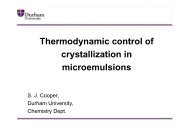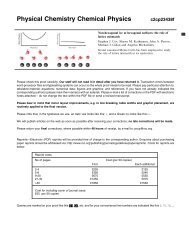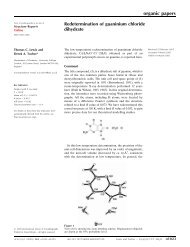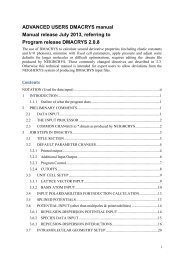An Introduction to the Theory of Crystalline Elemental Solids and ...
An Introduction to the Theory of Crystalline Elemental Solids and ...
An Introduction to the Theory of Crystalline Elemental Solids and ...
You also want an ePaper? Increase the reach of your titles
YUMPU automatically turns print PDFs into web optimized ePapers that Google loves.
36<br />
where C bulk <strong>and</strong> C surf are <strong>the</strong> coordination number <strong>of</strong> <strong>the</strong> bulk <strong>and</strong> <strong>the</strong> surface, respectively.<br />
For an fcc (111) surface eq. (34) yields a surface energy per a<strong>to</strong>m <strong>of</strong> 0.134E coh<br />
which gives results ra<strong>the</strong>r close <strong>to</strong> <strong>the</strong> ones plotted in Fig. 17(a). Refinements <strong>of</strong> <strong>the</strong><br />
tight binding treatment <strong>to</strong> account for repulsive forces between <strong>the</strong> a<strong>to</strong>ms improves <strong>the</strong><br />
agreement with experiment fur<strong>the</strong>r [136, 139].<br />
(b) Surface energy anisotropy<br />
As we have said <strong>the</strong> variation <strong>of</strong> surface energy with <strong>the</strong> type <strong>of</strong> crystal facet exposed is<br />
known as surface energy anisotropy. Generally it is known that <strong>the</strong> surface energy <strong>of</strong> a<br />
material is proportional <strong>to</strong> <strong>the</strong> number <strong>of</strong> broken bonds at <strong>the</strong> surface. Thus more open<br />
surfaces with more under-coordinated a<strong>to</strong>ms (i.e., more broken bonds) are less stable<br />
than <strong>the</strong> close-packed ones. This effect is qualitatively seen in <strong>the</strong> equilibrium crystal<br />
shapes <strong>of</strong> materials which expose close-packed surfaces at <strong>the</strong> expense <strong>of</strong> more open<br />
ones. First principles <strong>the</strong>ory provides a considerable body <strong>of</strong> quantitative support for<br />
this concept [64, 107, 127, 136–139, 141–143]. As an example we show in Fig. 17(b) <strong>the</strong><br />
computed DFT LDA surface energies <strong>of</strong> Methfessel et al. [136, 139] for model fcc (111),<br />
(100) <strong>and</strong> (110) surfaces <strong>of</strong> <strong>the</strong> 4d transition metals. Clearly for each metal <strong>the</strong> surface<br />
energy increases along with <strong>the</strong> corrugation <strong>of</strong> <strong>the</strong> surface, being lowest for <strong>the</strong> (111)<br />
surfaces <strong>and</strong> highest for <strong>the</strong> (110) surfaces.<br />
More recently Galanakis et al. [137, 142] have shown that for <strong>the</strong> surfaces <strong>of</strong> several fcc<br />
metals <strong>the</strong>re is an almost perfect linear correlation between <strong>the</strong> relative surface energies<br />
<strong>of</strong> different crystal facets <strong>and</strong> <strong>the</strong> number <strong>of</strong> broken bonds. This is shown in Fig. 17(c) for<br />
a number <strong>of</strong> fcc transition metal surfaces. Precisely <strong>the</strong> DFT LDA computed anisotropy<br />
ratios (relative <strong>to</strong> <strong>the</strong> (111) surface) for <strong>the</strong> (100), (110), (311), (331), <strong>and</strong> (210) surfaces<br />
<strong>of</strong> several transition metals are displayed. The solid horizontal lines are <strong>the</strong> ideal<br />
broken-bond ratios, which for <strong>the</strong> (100) surface, for example, is 4/3 since each a<strong>to</strong>m on<br />
this surface has only 8 nearest neighbors compared <strong>to</strong> 9 in <strong>the</strong> (111) surface. It can be<br />
seen that in every case <strong>the</strong> computed results fall on <strong>the</strong> ideal lines or within a few percent<br />
<strong>of</strong> <strong>the</strong>m. Calculations on o<strong>the</strong>r fcc metal surfaces, including an extensive series <strong>of</strong> 35 Pb<br />
surfaces <strong>and</strong> a large set <strong>of</strong> Cu surfaces predict that this trend also applies <strong>to</strong> <strong>the</strong>se substrates;<br />
typically computed surface energies were within 5 % <strong>of</strong> what would be predicted<br />
from <strong>the</strong> broken bond rule [138, 143]. It has been argued that <strong>the</strong> linear correlation in<br />
<strong>the</strong> relative surface energies is not inconsistent with eqn. (34) <strong>and</strong> <strong>the</strong> basic knowledge<br />
that <strong>the</strong> binding energy does not scale linearly with coordination number C, by recalling<br />
that <strong>the</strong> square root in eqn. (34) can be linearized in <strong>the</strong> regime <strong>of</strong> high coordination [137].<br />
Recent experimental results on Pb crystallites [126, 145, 146], provide valuable data with<br />
which <strong>to</strong> assess <strong>the</strong> validity <strong>of</strong> <strong>the</strong> trends predicted by DFT. Summarizing an extensive<br />
series <strong>of</strong> comparisons between experimental <strong>and</strong> DFT results [127, 138, 144, 147], it is<br />
found that <strong>the</strong> surface energy anisotropies obtained from experiment <strong>and</strong> predicted by<br />
<strong>the</strong>ory agree with each o<strong>the</strong>r reasonably well. In Fig. 17(d), for example, <strong>the</strong> experimental<br />
<strong>and</strong> <strong>the</strong>oretical surface energy anisotropies are plotted along <strong>the</strong> [001], [110] <strong>and</strong> [011]<br />
zones. At 323 <strong>and</strong> 473 K <strong>the</strong> experimental anisotropies are 11 <strong>and</strong> 6 %, respectively,<br />
whereas <strong>the</strong> T = 0 K <strong>the</strong>oretical anisotropy is at 25 %, expectedly higher than <strong>the</strong><br />
finite temperature experimental values. In addition <strong>the</strong> directions <strong>of</strong> <strong>the</strong> maxima <strong>and</strong><br />
minima <strong>of</strong> <strong>the</strong> <strong>the</strong>oretical anisotropy curve coincide with <strong>the</strong> experimental values.<br />
Moreover, when <strong>the</strong> <strong>the</strong>oretical equilibrium crystal shape - obtained by performing a







